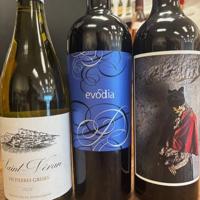— Low-alcohol wines please the palate, promote good health —
A $23 French chardonnay at 12.5% alcohol, an $11.99 Spanish red just shy of 15% and a $50 Napa Cab at 15.2%.
As consumer tastes move more to non-alcohol wines, lower alcohol ciders and other specialty beverages, the pressure on the wine industry to lower the heat continues.
Wine is viewed differently than other alcoholic beverages, mostly as something for dinner or relaxed enjoyment. The truth is much of the world’s favorite wine is high in alcohol. That makes those wines more of a health risk, particularly more of a risk as we age, and sometimes even difficult to drink.
Traditionally, French wines are somewhat lighter in alcohol content than American or Italian varieties.
Now, for a quick bit of education.
Riper grapes create higher sugars and higher sugars create higher alcohol. What are two of the warmest and sunniest regions in the world? California’s coastal region and the hot expanse of Tuscany and northern Italy produce high-alcohol wines.
A glossary would be helpful:
Low alcohol wines (under 12.5%): Italian Prosecco, French Vouvray, California White Zin;
Medium alcohol wines (12.5-13.5%): Champagne, most French whites, French Beaujolais and Burgundy, Spanish Rioja.
High alcohol wines (13.5-14.5%): Many Chardonnays, Malbec, Shiraz, California Pinot Noir, Rhone Reds and Italian Barolo;
Very high alcohol (more than 14.5%): California Petit Sirah and Zinfandel, some California Cabernet, Italian Amarone
This is not an all-inclusive list, by any means, but it’s a good guide.
The drawbacks to high-alcohol wine should be obvious, and you’ll find little disagreement from medical and health professionals. Too much booze can lead to sleep deficiency, obesity, heart disease, fertility issues and pancreatitis.
Acid reflux, indigestion and low-grade headaches can be added to the side effects. I started having adverse effects from higher alcohol red wine in recent years. And perhaps I should add that I drink less wine now than in previous years. I’ve heard similar stories from older customers shopping in the wine store where I work part time.
I decided to do a little alcohol survey in the shop. The demand for lower-alcohol has not gone unnoticed. I looked at 10 random reds and 10 whites at varying price points.
The reds ranged from 13.5% alcohol to over 15%. There are fewer wines hitting the 15% level now than just a few years ago. If you are sensitive to the booze, try reds in the 13.5%-14% range. My random selection of 10 whites ranged from 9% to 13%. Most whites will be in the 11.5%-12.5% range.
California Cabernet, Zinfandel and some blends often top out around 15%. European reds are generally slightly lower in alcohol. Some big Italian reds can be hot.
How many people buy wine based on alcohol? The answer is very few, but it’s starting to creep into the conversation. It’s also a bit of a national conversation usually centered around California and Australian reds.
How do you know the alcohol content in your wine?
That’s really easy. The alcohol level in any bottle of wine sold in the USA must have the alcohol content on the label. Some producers make it tough to find, but you’ll come across it on the bottom corner of the front label or buried in a bunch of small type on the back label.
There is also plenty of controversy about how accurate alcohol measurements are, especially from California. Oddly enough, California liquor laws allow a 1.5% variance on wine below 14% and a 1% leeway for those over 14%.
So, an easy solution is to buy French wine, right?
But, for enjoyment purposes if you want a big, hot Napa Cab just have a glass of water nearby and sip it alternatively with the wine. The simple glass of water is a solid solution that works and doesn’t dilute the enjoyment of a hefty red wine.
The point is not to drink more of one wine or less of another. The goal is to educate yourself and know what you are drinking. The risks are significant to heavy and moderate drinkers.
Enjoy your big red wines, but be sure to mix in some whites and lighter reds for your health. And, always drink in moderation.
Howard Hewitt, a retired newspaper journalist and former winery employee, writes quarterly columns on wine.


Dining and Cooking